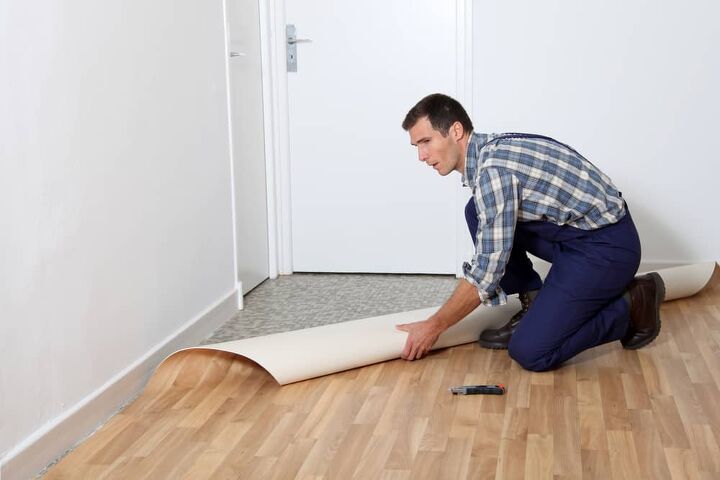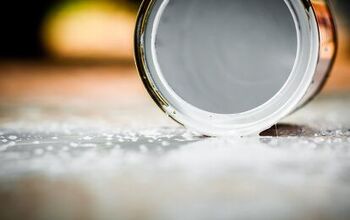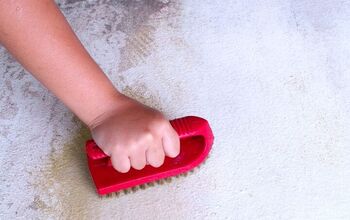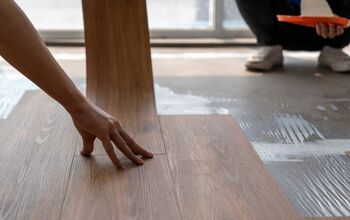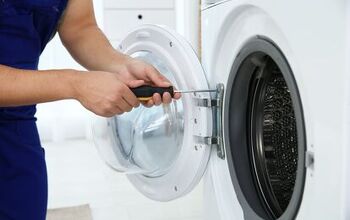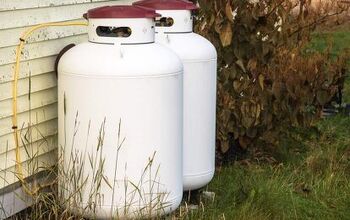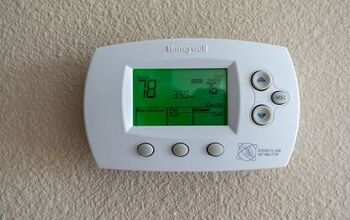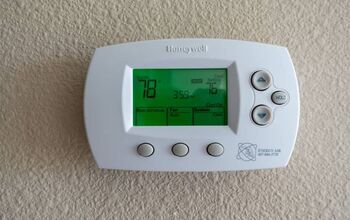How To Remove Linoleum Glue From Concrete Floor (Do This!)

Are you planning a DIY project to remove linoleum flooring and glue from a concrete subfloor? If you are, is the issue of extracting stubborn glue buildup making you procrastinate? You can actually forget your worries and complete this task with confidence by using some simple steps for glue removal.
Since its invention in 1870, linoleum has been used as a popular flooring material for homes and business facilities. Containing ground cork, pigments, gums, and oxidized linseed oil, it is eco-friendly, durable, and found in older and new homes. You and many other homeowners may want to remove worn, outdated, or unattractive linoleum and linoleum glue.
Just by using simple tools like scrapers, heating guns, irons, or adhesive removers, the problem can be solved. Start by using a hand scraper, and if a stronger tool is needed, change to a power scraper or grinder. Glue buildup can also be eliminated with boiling water, a heat gun, a clothing iron, or by applying adhesive removers.
These basic methods of linoleum glue removal almost sound too good to be truly effective. Yet if you have plans to renovate floors, which require removing linoleum, you can do this simply and cost-efficiently. After cutting and extracting the linoleum strips or tiles, the underlying glue removal is not complicated.
Do You Need Concrete, Brick, or Stone Pros?
Get free, zero-commitment quotes from pro contractors near you.

Effective Methods for Removing Linoleum Glue
Tools Needed
A wide variety of basic renovating tools and aids can be used to accomplish your flooring glue removal, including:
- Wide putty knife or utility knife
- Floor scraper or paint scraper
- Brick chisel
- Hammer
- Heat gun or iron
- Reciprocating saw, oscillating saw, or toe kick saw
- Drill
- Screwdriver
- Sander
- Water and soap dish
Common, simple, and effective methods for linoleum glue removal from concrete include the following:
1. Scraping Glue Away
Most flooring experts recommend trying scraping as your first method of removing linoleum glue from concrete. If the blade of your hand scraper and your muscle power fail to remove stubborn glue, try other methods. Your next choice can be a razor blade scraper.
If these options do not bring satisfactory results, try a power scraper, which can do all the hard work. If your toolbox does not already include a power scraper, you can borrow one from a tool rental shop. If you have a handheld reciprocating saw, you can add a scraper attachment to scrape away the glue.
2. Softening Glue with Boiling Water
In some cases, simply applying boiling water to linoleum glue that adheres to concrete can loosen the glue. Let the water soak into the glue for a while until the adhesive softens and then try removing it. If some glue is still difficult to loosen, apply a mixture of hot water and detergent for easier removal.
You can also pour boiling water on linoleum glue, letting it sit for a short time. While the water is still hot, try peeling the glue from the concrete using a hand scraper or putty knife. Before choosing this method of glue removal, ensure that there are no wires or electrical outlets near floor level.
3. Using a Heat Gun or Hot Iron
You can remove linoleum glue from concrete surfaces often with the use of a heat gun. Simply turn on the heat and direct it at the hardened buildup of glue. If your collection of tools does not include a heat gun, try using a hot clothing iron.
When using an iron, position multiple layers of newspaper over the glue to prevent messy glue buildup on your iron. Soften the glue by moving the iron back and forth on the newspaper. Then you should be able to finish the job with a hand scraper or putty knife.
4. Using a Chemical Adhesive Remover
Stubborn accumulations of linoleum glue on concrete may require applications of a chemical adhesive remover. If you normally refrain from using harsh chemical products, choose an eco-friendly brand. Whether you use a chemical remover with artificial ingredients or green components, be sure to follow the user instructions.
It typically takes about one gallon of chemical solvent for every 100 square feet of concrete sub-flooring. Leave the solvent on the concrete for 15 minutes to allow the glue to soften for removal by scraping. Since most solvents work best when undiluted, apply the remover to a small flooring section first to detect possible damage.
Smoothing Concrete Subfloor After Linoleum Removal
The linoleum flooring in your home or company facilities may have been in place when you purchased the property. If it was, you may not know whether there is wood sub-flooring beneath the linoleum. You may only discover this layer once you begin cutting and ripping up the linoleum.
When you reach the concrete floor beneath the linoleum and any sub-flooring material, you can assess the task ahead. If there is extensive glue still adhering to the concrete, you may need to start extracting it with power scrapers. Yet starting the process with the use of hand scrapers and sanders is advisable.
You can then determine if power grinders or scrapers are needed to complete the job. If you intend to use the concrete substrata, hardwood, or tile for new flooring, the concrete surfaces must be smooth. Once you are successful with removing most of the linoleum glue, you need to sand the concrete to superior smoothness.
Helpful Tips for Removing Different Glue Types
According to when your house or commercial building was built, different types of flooring adhesives may have been used. Some helpful tips for removing various linoleum adhesives from concrete subfloor include the following:
Vinyl Adhesives: These forms of glue cannot be scraped away easily. Nor can they be softened sufficiently with boiling water or by using a heating gun or iron. These adhesives must be dislodged with the use of a solvent.
Thin Set Mortar: This type of adhesive is highly durable and water-resistant. You may need a hammer, screwdriver, or chisel to fully remove this mortar from concrete. Although it is not commonly used today to secure linoleum to sub-flooring, it was sometimes used in years past.
Mastic: This organic compound adhesive is used mainly as a tile and concrete gluing agent. It dissolves rapidly in water and is actually easy to remove.
Asbestos Adhesives: Prior to 1984, asbestos was often combined with flooring adhesives to strengthen them. If you discover black glue that resembles tar on your concrete subfloor, contact a professional asbestos removal company. Never attempt to remove this form of adhesive on your own since it is a serious health hazard.
Related Questions
Is there a natural citrus-based product for removing linoleum glue from concrete?
Yes. There are currently some eco-friendly adhesive removers based on citric acid activity. They leave no unpleasant odors and if spilled, they can safely be cleaned up using water. Available in both liquid and paste form, these solvents are easy to apply to either horizontal or vertical surfaces.
Are there any natural soy formulas for linoleum glue removal?
Yes, there are soy-based adhesive removers available today. They are particularly helpful for softening old, very hardened flooring glues. For best results, apply the soy adhesive solvent and let it sit for six to ten hours for complete glue removal.
A friend told me recently that you can remove linoleum floor tiles from concrete using dry ice. Is this true? Will the dry ice also remove the linoleum glue?
Yes, you can use dry ice and an adhesive solvent in a ventilated room to remove linoleum tiles and glue. Be sure to wear thick gloves or use pincers to hold the dry ice.By placing it over a tile and leaving it for several minutes, you can loosen the tile enough for removal. You can then apply the adhesive solvent to the concrete substrate to soften and scrape away the glue.
Do You Need Concrete, Brick, or Stone Pros?
Get free, zero-commitment quotes from pro contractors near you.

In Summary
There are varied effective methods of removing linoleum glue from concrete today. You may find that using hand or power scrapers or grinders works best for your needs. In some cases, applying boiling water or a chemical adhesive solvent may do the job.
Today, many eco-friendly products can also fully remove these glues. You can buy natural adhesive removing agents that work effectively and are based on citric acid activity. There are also soy-based products on the consumer market that remove even stubborn linoleum glue from concrete.
All of these adhesive solvents are reliable and effective, removing hardened glue deposits effectively. They are low-cost and can be purchased online or at your local hardware store or home improvement center. Considering the expense of hiring professionals to perform this task, think of the great money-saving benefits of using cost-effective methods.
Once you determine the ideal method, tools, or products for the complete removal of linoleum glue, you will accomplish your goal. Your floor’s concrete substrata will be pristinely clean and smooth without a trace of glue remaining.
More Related Guides

We are a team of passionate homeowners, home improvement pros, and DIY enthusiasts who enjoy sharing home improvement, housekeeping, decorating, and more with other homeowners! Whether you're looking for a step-by-step guide on fixing an appliance or the cost of installing a fence, we've here to help.
More by Upgraded Home Team



